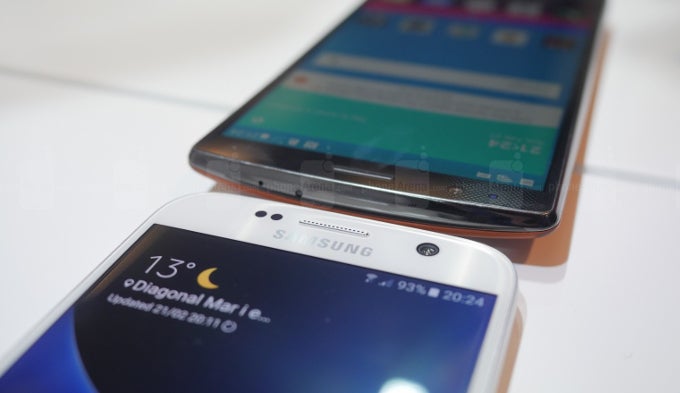Samsung Galaxy S7 vs LG G4: first look

Design
Metal and glass is what Samsung's been doing for its flagships and higher-tier midrangers since 2015. The Galaxy S6 was a beautiful handset in its own right, but the S7 takes the bling even further, with refined shapes, softening its rectangular shape further, and borrowing the arched corners on the back from the Note 5. Its display still has a 5.1-inch diagonal, but its bezels are slightly thinner (70.64% screen-to-body ratio), making it feel nice and compact. As with the Galaxy S6, the S7's front and back are covered by Gorilla Glass 4 and its body is made out of metal. The new flagship sure looks good, but, unfortunately, it still attracts way too many fingerprint smudges – that's just the nature of the glass back, unfortunately. It is also sealed shut, so the battery is, again, not swappable.
Display
Samsung's Galaxy S7 rocks a 5.1-inch, 1440 x 2560 resolution Super AMOLED display. Thanks to the various modes, the screen can be set to either have super-punchy, vivid colors that the AMOLED tech is known for, or a more accurate, subdued color reproduction. Thanks to the versatility and super-crisp resolution, it can easily be called the best display on the market right now.
The G4 has a Quantom IPS 5.5-inch screen, also with a 1440 x 2560 resolution. So, it's slightly larger, and still very, very sharp. Its colors are punchy and vivid as well, but slightly off. Unfortunately, there's no way to correct that through software settings or presets.
Interface
Samsung's TouchWiz finally looks streamlined and polished. Design elements throughout its various apps and settings fit together in a coherent way, and the interface has been slimmed down to be much less laggy and stuttery than what it was in Galaxy S5 days. Yet it still managed to retain a lot of UX features, such as smart wake / smart call / smart stay, the security manager, et cetera. The interface finally feels like a finished product that runs consistently well throughout.
If you've been following closely, you probably know that the new LG G5 UI lacks an app drawer and split screen functionality. Apparently, removing them was a step in simplifying the interface, according to LG. We don't know whether the same will happen to the LG G4 with a future software update, but we'd think LG wouldn't want to upset G4 users who are used to having the features.
Processor and Memory
The LG G4 is equipped with a hexa-core Snapdragon 808 and 3 GB of RAM. Not the most powerful processor of the 2015 line, and it often shows. The handset runs smoothly with the occasional stutter, and it can definitely sweat and pant when more demanding tasks are involved.
The Samsung Galaxy S7 has 4 GB of RAM and the brand-new Snapdragon 820 SoC (or Exynos 8890 for select markets) humming under its hood. We ran some quick benchmarks on the Exynos variant, and if they are anything to go by — the Galaxy S7 is going to be a true powerhorse. Powerusers that demand nothing but bleeding edge performance from their handset will find it hard not to go with the Galaxy S7 in this face-off.
Camera
The G4 has a higher 16 MP resolution, with an F1.8 aperture and 1.12μm. It was a great performer in low-light conditions when compared to competitors back in 2015, but the Galaxy S7 may be able to score a definite win when it comes to dark photos. Unfortunately, we haven't gotten the chance to do a side-by-side comparison yet, but after experiencing both cameras on their own, we can definitely say that both smartphones make great photos.
On the front, the Galaxy S7 has a 5 MP snapper, while the G4 has an 8 MP one. So, in theory, LG's offering could possibly take more detailed mugshots, but, as mentioned, we've yet to side-by-side them in equal conditions.
Battery
Inside the Galaxy S7, we have a 3000mAh battery. Given the the alleged power-efficiency 14 nm FinFET process, upon which the Snapdragon 820 and Exynos 8890 were built, we’d expect it to last sufficiently long between charges (pre-launch rumors claimed a 2-day battery life), although we've got to put the handset through its paces to be sure. We are especially curious to see whether the always on display feature drains too much juice.
One trick that the S7 has up its sleeve is wireless charging. The phone is compatible with pretty much every Qi wireless charging pad around, and even supports rapid wireless charging.
Expectations
All in all, the Samsung Galaxy S7 looks like an impressive smartphone, capable of giving any of its competitors a run for their money. It is, hands-down, one of the best choices for users that want nothing but the top out of the Android handsets out there. Its design catches the eye, its camera looks very promising, and its hardware should be able to handle anything you throw at it.
The LG G4 could be a worthy alternative, especially since we expect its price to drop now that the G5 has been announced. It may not have as much raw processing power, and it may have a less shiny, plastic build, but the leather-back design has its appeal and that 16MP camera on its back does not disappoint. Besides, the G4 offers you a removable battery, a slightly larger display, albeit with inaccurate colors, and a built-in IR blaster.















Things that are NOT allowed: